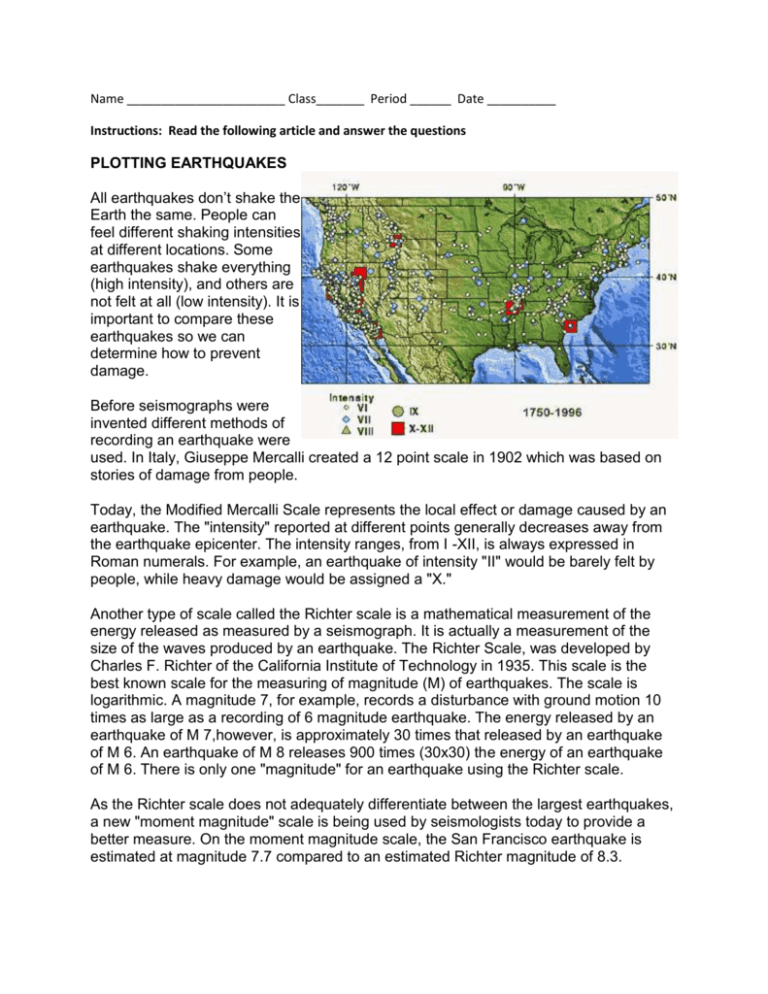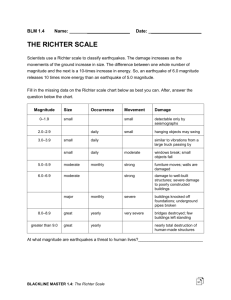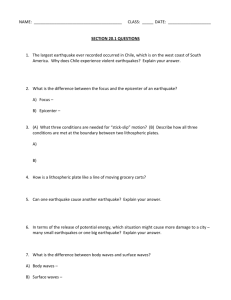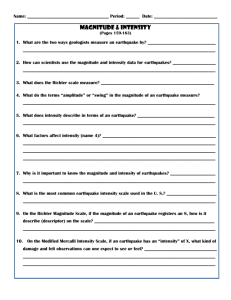Plotting Earthquakes - Madeira City Schools
advertisement

Name _______________________ Class_______ Period ______ Date __________ Instructions: Read the following article and answer the questions PLOTTING EARTHQUAKES All earthquakes don’t shake the Earth the same. People can feel different shaking intensities at different locations. Some earthquakes shake everything (high intensity), and others are not felt at all (low intensity). It is important to compare these earthquakes so we can determine how to prevent damage. Before seismographs were invented different methods of recording an earthquake were used. In Italy, Giuseppe Mercalli created a 12 point scale in 1902 which was based on stories of damage from people. Today, the Modified Mercalli Scale represents the local effect or damage caused by an earthquake. The "intensity" reported at different points generally decreases away from the earthquake epicenter. The intensity ranges, from I -XII, is always expressed in Roman numerals. For example, an earthquake of intensity "II" would be barely felt by people, while heavy damage would be assigned a "X." Another type of scale called the Richter scale is a mathematical measurement of the energy released as measured by a seismograph. It is actually a measurement of the size of the waves produced by an earthquake. The Richter Scale, was developed by Charles F. Richter of the California Institute of Technology in 1935. This scale is the best known scale for the measuring of magnitude (M) of earthquakes. The scale is logarithmic. A magnitude 7, for example, records a disturbance with ground motion 10 times as large as a recording of 6 magnitude earthquake. The energy released by an earthquake of M 7,however, is approximately 30 times that released by an earthquake of M 6. An earthquake of M 8 releases 900 times (30x30) the energy of an earthquake of M 6. There is only one "magnitude" for an earthquake using the Richter scale. As the Richter scale does not adequately differentiate between the largest earthquakes, a new "moment magnitude" scale is being used by seismologists today to provide a better measure. On the moment magnitude scale, the San Francisco earthquake is estimated at magnitude 7.7 compared to an estimated Richter magnitude of 8.3. Seismograms record the energy emitted by seismic or earthquake waves that radiate from the focus (point at which earthquake begins). Seismograms are created by machines called seismographs. Seismograms are used by seismologists (scientists who study earthquakes) to mathematically describe the magnitude of an earthquake. Earthquakes generate many different types of seismic waves. Two major types are P (push/pull, compressional, or primary) and S (shear or secondary). Seismograms will record P-wave arrivals before S-wave arrivals. Surface waves are also generated that travel on the surface of the crust. 1. Who developed the first 12 point earthquake measurement scale in 1902? 2. What is the name of a modern earthquake scale that measures the size of the waves produced by an earthquake? 3. What does the Richter scale not adequately differentiate between? 4. Who are seismologists and What do they use to mathematically describe the magnitude of an earthquake? 5. What are two major types of seismic waves measured by seismograms and which seismic wave is measured first?








